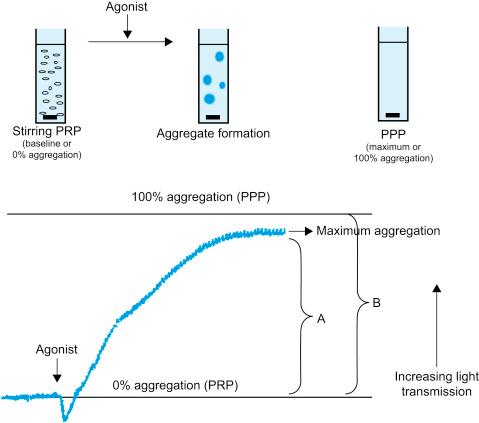Physical Address
304 North Cardinal St.
Dorchester Center, MA 02124
The platelet is a dynamic structure, covered externally with glycoprotein (GP) receptors. Internally, the platelet possesses alpha (α) granules, which contain a number of proteins, including von Willebrand factor (VWF), fibronectin, and fibrinogen; and dense (δ) granules, containing adenosine triphosphate (ATP), adenosine diphosphate (ADP), serotonin, pyrophosphate, magnesium, and calcium. Primary hemostasis is initiated by platelet adhesion to vessel wall components at the site of vessel injury. VWF is key for this process at a high shear rate. Platelet activation occurs through exposure to collagen and thrombin and leads to release of granule contents. Aggregation of additional platelets produces a physical barrier. Platelets participate in clot formation through release of stored factors and provision of a surface for assembly of coagulation factor complexes to complete the platelet plug.
In vitro platelet aggregation (PAGG) testing measures the response of platelets to added aggregating agents, or agonists, with measurements that primarily reflect activation, aggregation, and, with some instruments, secretion. Although PAGG testing is both time- and labor-intensive, requires use of fresh blood, and may be difficult to interpret, it remains the gold standard for assessing platelet function.
Traditionally, PAGG has been tested by light-transmission aggregometry (LTA), which measures change in optical density (OD) of stirred platelet-rich plasma (PRP) when an aggregating agent (agonist) is added ( Fig. 140.1 ). As platelets aggregate, more light is transmitted because of decreased absorbance as a result of decreased platelet dispersion. Patient’s PRP is set at 0% aggregation and autologous platelet-poor plasma (PPP) at 100%. OD versus time is recorded, which may reveal lag phase, shape change, and first and second waves of aggregation. Calculated parameters include the aggregation rate (slope), maximum amplitude, and percent aggregation.

Become a Clinical Tree membership for Full access and enjoy Unlimited articles
If you are a member. Log in here